- Home
- »
- Next Generation Technologies
- »
-
4D Printing Market Size, Share And Growth Report, 2030GVR Report cover
![4D Printing Market Size, Share & Trends Report]()
4D Printing Market Size, Share & Trends Analysis Report By Material (Programmable Carbon Fiber, Programmable Textiles), By End-use (Military & Defense, Aerospace, Automotive, Textile, Healthcare), By Region, And Segment Forecasts, 2024 - 2030
- Report ID: 978-1-68038-155-9
- Number of Report Pages: 250
- Format: PDF, Horizon Databook
- Historical Range: 2017 - 2023
- Forecast Period: 2024 - 2030
- Industry: Technology
4D Printing Market Size & Trends
The global 4D printing market size was estimated at USD 156.8 million in 2023 and is anticipated to grow at a CAGR of 35.8% from 2024 to 2030. 4D printing is an advanced form of 3D printing that creates objects capable of changing shape or functionality over time in response to environmental stimuli, such as temperature, moisture, or light. This technology utilizes smart materials that adapt and transform post-fabrication to meet specific needs or conditions. Uses of 4D printing include creating self-adjusting components for aerospace, adaptive medical implants, and responsive structures for smart buildings.
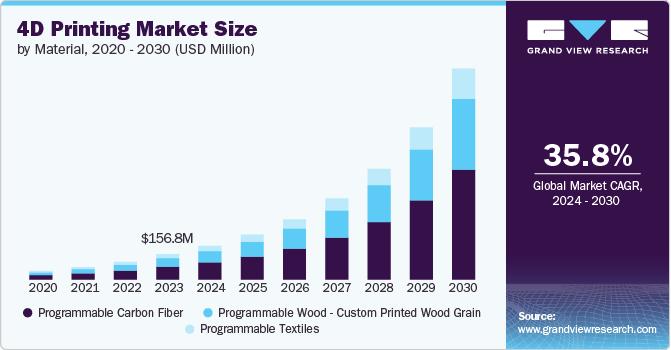
A smart container is a shipping container equipped with advanced technologies such as IoT sensors, GPS, and real-time tracking systems to monitor and manage its contents and conditions during transit. These containers are used for ensuring the safety, security, and integrity of goods, optimizing supply chain efficiency, and providing real-time data on location, temperature, humidity, and other environmental factors. The growth of the market is attributable to factors such as increased focus on end-to-end (E2E) supply chain visibility, increasing demand for monitoring and controlling internal container conditions, and rapid adoption of IoT devices by logistics and shipping companies.
Advances in material science are significantly driving the growth of the 4D printing market by enabling the development of materials that change properties over time. Innovations such as shape-memory polymers and nanomaterials enhance the performance and adaptability of 4D printed structures. The emergence of multi-material printing allows for complex, multifunctional designs, while biocompatible materials and conductive materials open new possibilities in medical and electronic applications. Ongoing research and improvements in material properties are expanding the market's potential applications and reducing costs. These advancements are foundational to the evolution of 4D printing technology, leading to more efficient and effective solutions.
The growing demand for smart and adaptive materials is propelling the 4D printing market by driving industries to seek versatile solutions that respond to environmental stimuli. Smart materials, which adjust properties in response to temperature, pressure, and other factors, are increasingly used in automotive, aerospace, construction, consumer electronics, and healthcare applications. The pursuit of sustainability and energy efficiency also fuels this demand, as smart materials can reduce resource consumption and enhance functionality. Research and development efforts continuously enhance these materials, leading to new applications and innovations. This growing awareness and adoption of smart materials are expanding the target market.
The increasing adoption of 4D printing in healthcare and medical applications is a major driver of market growth. The technology is revolutionizing the design and use of implants, prosthetics, and medical devices, enabling the creation of smart implants and self-healing materials that improve patient outcomes. Bioprinting is advancing regenerative medicine by producing customized tissues and organs, offering new solutions for injuries, diseases, and organ transplantation. The development of biocompatible and biodegradable materials further supports the safety and effectiveness of medical devices. Investment and collaboration between healthcare professionals and engineers are driving innovation in this field. Overall, the growing use of 4D printing in healthcare is significantly contributing to market expansion.
Market Concentration & Characteristics
The degree of innovation in the 4D printing market is exceptionally high, driven by the development of smart materials that can adapt and respond to environmental stimuli. Researchers and companies are continuously exploring new applications across industries such as aerospace, healthcare, and automotive, where the demand for advanced, multifunctional components is growing. Innovations in programmable materials, such as carbon fiber and custom wood grain, are pushing the boundaries of what's possible in manufacturing. Additionally, collaborative efforts between academia, industry, and government are accelerating breakthroughs in 4D printing technology. This dynamic environment ensures that the market remains at the cutting edge of technological advancements.
The level of product launches in the target market is rapidly increasing, reflecting the market's dynamic and innovative nature. Companies are actively introducing new 4D printed products across various sectors, including aerospace, automotive, and healthcare, where adaptive and responsive materials are highly valued. These launches often showcase advancements in smart materials, such as programmable carbon fiber and shape-shifting polymers, designed to meet specific industry needs. Startups and established firms alike are leveraging these product launches to gain a competitive edge and establish leadership in this emerging field. The frequent introduction of new 4D printing solutions highlights the market's potential for continued growth and technological evolution.
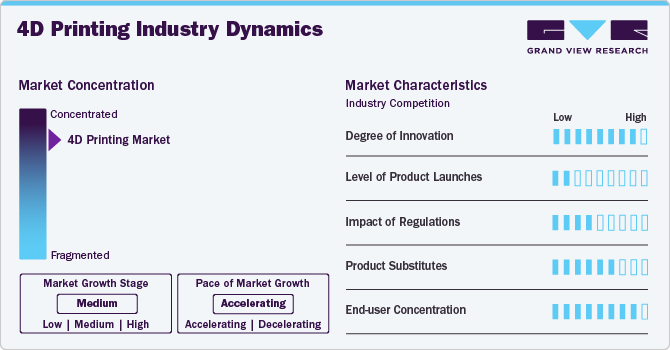
Regulation significantly impacts the target market by shaping the development and commercialization of new technologies. Stricter standards and guidelines are emerging to ensure safety, quality, and environmental sustainability, particularly as 4D printing expands into critical industries like aerospace and healthcare. Compliance with these regulations can drive innovation, as companies must meet specific criteria to bring their products to market. However, regulatory challenges can also slow down the adoption of 4D printing, especially in regions with complex approval processes. Overall, evolving regulations are both a catalyst for and a barrier to the growth of the 4D printing market, influencing its pace and direction.
The impact of product substitutes in the target market can be classified as moderate. Product substitutes have a notable impact on the 4D printing market, creating competitive pressure that can influence pricing and adoption rates. Traditional manufacturing methods, such as 3D printing and advanced composites, are often seen as alternatives, especially in industries where 4D printing's unique benefits are not yet fully required. These substitutes can slow the market's growth by offering more established and sometimes cost-effective solutions. However, the distinct advantages of 4D printing, such as adaptability and smart material capabilities, help it carve out a niche where substitutes cannot compete. As 4D printing technology matures and proves its value, the impact of substitutes is likely to diminish, allowing for greater market penetration.
End-user concentration in the target market is currently high, with a focus on specific sectors such as aerospace, automotive, and healthcare. These industries are leading the adoption of 4D printing due to their demand for advanced, adaptable materials and components. The concentration is driven by the technology's ability to offer unique solutions that enhance performance and functionality in these critical fields. As 4D printing technology advances, it is expected to diversify into additional sectors, reducing the current high concentration. This shift will broaden the market's reach and application, potentially lowering the dependence on a few key industries.
Material Insights
The programmable carbon fiber segment held the largest market share of 50.9% in the 4D printing market, driven by its exceptional strength-to-weight ratio and adaptability. This material's ability to change shape in response to environmental stimuli makes it ideal for aerospace and automotive applications, where lightweight and durable components are crucial. Additionally, its programmability allows for the creation of highly customized and responsive structures. Industries are increasingly adopting programmable carbon fiber for its potential to enhance product performance and sustainability. The material's versatility also supports innovation in various sectors, including defense and medical devices. Its dominance in the market reflects the growing demand for advanced, smart materials in cutting-edge technologies.
The programmable wood-custom printed wood Grain segment registered the second fastest CAGR of 35.8% in the 4D printing market, driven by its unique aesthetic appeal and sustainability. This material's ability to change shape and texture in response to environmental conditions makes it highly desirable for applications in furniture, interior design, and architecture. The customizability of wood grain patterns allows for tailored, visually appealing products that resonate with eco-conscious consumers. Additionally, the segment's growth is fueled by advancements in printing technology that enhance the durability and functionality of wood-based materials. Its rapid adoption reflects the increasing demand for innovative, environmentally friendly solutions in various design and construction industries.
End-use Insights
The military and defense segment dominated the 4D printing market with a market share of 34.5% due to its need for advanced, adaptive materials that enhance operational effectiveness and mission success. 4D printing technology offers significant advantages such as the ability to create self-healing materials and adaptive components that respond to environmental conditions. This capability is crucial for developing innovative equipment and protective gear that can withstand extreme conditions. Additionally, the sector's substantial investment in research and development drives the adoption of cutting-edge technologies such as 4D printing. The segment's dominance reflects its focus on leveraging technological advancements to gain a strategic edge and improve defense capabilities.
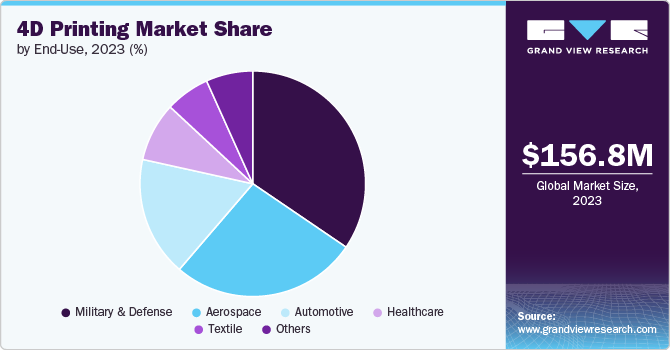
The automotive segment registered the fastest CAGR of 36.6% in the 4D printing market due to its growing need for innovative materials that enhance vehicle performance and efficiency. 4D printing technology enables the creation of adaptive parts and components that can adjust to varying conditions, which is highly valuable for automotive applications. The industry's focus on lightweight and customizable solutions to improve fuel efficiency and safety drives the rapid adoption of 4D printing. Additionally, advancements in 4D printing offer the potential for significant cost savings and production flexibility, further accelerating growth in the automotive sector. The sector's commitment to integrating cutting-edge technologies to meet evolving consumer demands supports its leading position in the market.
Regional Insights
North America held the largest market share of 36.3% in the target market in 2023 primarily due to its strong emphasis on technological innovation and research and development. The region's advanced industrial infrastructure supports the rapid adoption of emerging technologies, including 4D printing. Major companies and research institutions in the U.S. and Canada are leading significant advancements and applications in sectors such as aerospace, defense, and automotive. Additionally, substantial investments from both private and public sectors enhance the development and commercialization of 4D printing technologies. The presence of a well-established network of technology firms and startups further contributes to North America's market dominance. The region's proactive approach to integrating cutting-edge technologies solidifies its leadership in the target market.
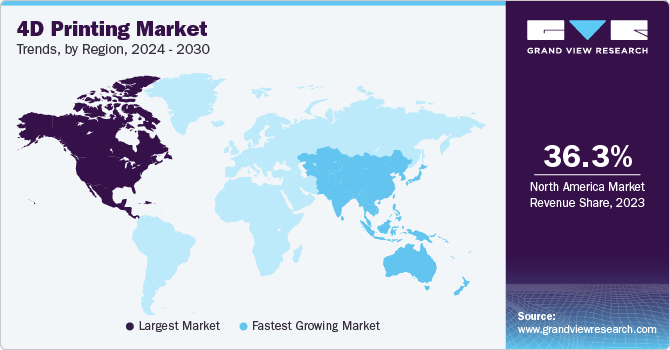
U.S. 4D Printing Market Trends
4D printing market in the U.S. is driven by substantial investments in research and development, which fuel technological advancements and innovation. Key industries such as aerospace, defense, and automotive are rapidly adopting 4D printing for its ability to create adaptive and high-performance materials. The presence of leading technology firms and research institutions accelerates the development and deployment of 4D printing solutions. Additionally, supportive government initiatives and funding programs further bolster market expansion by promoting advanced manufacturing technologies.
Asia Pacific 4D Printing Market Trends
4D Printing Market in Asia Pacific registered the fastest CAGR of 36.3% in the target marketdue to its rapid industrialization and increasing investment in advanced manufacturing technologies. The region's growing focus on innovation in sectors such as automotive, aerospace, and healthcare drives demand for adaptive and responsive materials. Emerging economies in Asia Pacific are investing heavily in research and development to boost technological capabilities and infrastructure. Additionally, the presence of a large number of technology startups and collaborations between local firms and international companies accelerate market growth. The region’s supportive government policies and initiatives aimed at fostering high-tech industries further contribute to its leading growth rate.
4D printing market in China held the largest market share of 22.5% in the target market in Asia due to its significant investments in advanced manufacturing technologies and research and development. The country's rapid industrialization and focus on innovation in key sectors such as automotive and aerospace drive the high demand for 4D printing solutions. Additionally, government initiatives and policies supporting technological advancement and infrastructure development further propel China’s dominant position in the market.
Europe 4D Printing Market Trends
Europe held a significant market share of 26.9% in target market due to its strong focus on technological innovation and advanced manufacturing. The region benefits from substantial research and development efforts by leading institutions and companies, particularly in aerospace, automotive, and healthcare sectors. European countries also have robust government support through funding and initiatives aimed at fostering high-tech industries. Additionally, Europe's emphasis on sustainability and smart materials aligns well with the capabilities of 4D printing, driving its market share.
The 4D Printing Market in Germany is experiencing significant growth, particularly due to the country’s leadership in the automotive industry. Germany’s strong emphasis on technological innovation and advanced manufacturing drives demand for adaptive and high-performance 4D printed materials in automotive applications. The presence of leading research institutions and major technology firms accelerates market development in this sector. Additionally, supportive government policies and substantial investments in R&D further contribute to the market’s robust expansion.
Key 4D Printing Company Insights
Some of the key companies operating in the 4D Printing Market include Autodesk, Inc. and Stratasys, among others.
-
Autodesk Inc. is an American multinational software company. The company develops software for various fields, including engineering, architecture, manufacturing, construction, entertainment, and media. The company is well-known for its AutoCAD software and is involved in the development of various other software for designing and engineering purposes.
-
Stratasys is a U.S.-based manufacturer of three-dimensional production systems and printers. It is a technology company offering rapid prototyping and solutions for direct digital manufacturing purposes through additive manufacturing. The company caters to a broad range of customers, including aerospace, industrial tooling, healthcare, automotive, entertainment, dental, consumer electronics, and education.
Organovo Holdings, Inc., and CT CoreTechnologie Group are some of the emerging market companies in the target market.
-
Organovo Holdings, Inc. is a U.S.-based biotechnology company involved in the desktop 3D printing of human tissue for medical research. The company designs and develops 3D functional human tissue using its 3D biotechnology. It is focused on building functional, living human tissue similar to the surrounding native tissues. Organovo’s specialties include 3D bioprinting, desktop 3D printing, human disease research & modeling, liver biology, and drug discovery and development.
-
CT CoreTechnologie Group is an innovative player in the emerging 4D printing market, focusing on advanced software solutions for additive manufacturing and 4D printing applications. Its technology enables the creation of smart materials that can change shape or property over time in response to environmental stimuli. The company provides comprehensive CAD interoperability solutions that support complex 4D printing processes, ensuring seamless data exchange and model accuracy.
Key 4D Printing Companies:
The following are the leading companies in the 4D printing market. These companies collectively hold the largest market share and dictate industry trends.
- Autodesk, Inc.
- Stratasys
- HP Development Company, L.P.
- Organovo Holdings, Inc.
- Materialise
- ENVISIONTEC US LLC
- ExOne
- Dassault Systemes
- CT CoreTechnologie Group
4D Printing Market Report Scope
Report Attribute
Details
Market size value in 2024
USD 207.3 million
Revenue forecast in 2030
USD 1,297.5 million
Growth rate
CAGR of 35.8% from 2024 to 2030
Historical data
2017 - 2023
Forecast period
2024 - 2030
Report updated
August 2024
Quantitative units
Revenue in USD million and CAGR from 2024 to 2030
Report coverage
Revenue forecast, company ranking, competitive landscape, growth factors, and trends
Segments covered
Material, end-use, region
Regional scope
North America; Europe; Asia Pacific; Latin America; MEA
Country scope
U.S.; Canada; Mexico; UK; Germany; France; China; Japan; India; South Korea; Australia; Brazil; KSA; UAE; South Africa
Key companies profiled
Autodesk Inc.; Stratasys; HP Development Company, L.P.; Organovo Holdings, Inc.; Materialise; ENVISIONTEC US LLC; ExOne; Dassault Systèmes; CT CoreTechnologie Group.
Customization scope
Free report customization (equivalent up to 8 analysts working days) with purchase. Addition or alteration to country, regional & segment scope.
Pricing and purchase options
Avail customized purchase options to meet your exact research needs. Explore purchase options
Global 4D Printing Market Report Segmentation
This report forecasts revenue growth at global, regional, and country levels and provides an analysis of the latest industry trends in each of the sub-segments from 2017 to 2030. For this study, Grand View Research has segmented the global 4D printing market report based on material, end-use, and region:
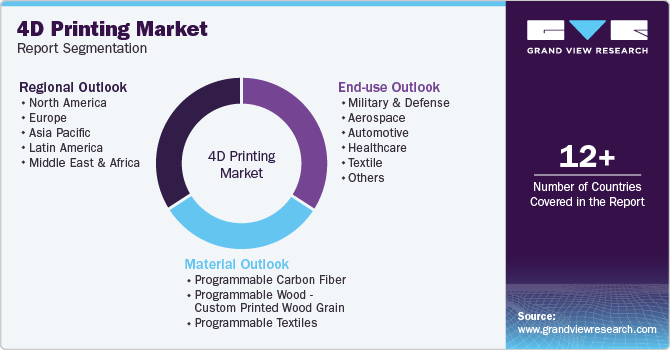
-
Material Outlook (Revenue, USD Million, 2017 - 2030)
-
Programmable Carbon Fiber
-
Programmable Wood - Custom Printed Wood Grain
-
Programmable Textiles
-
-
End-use Outlook (Revenue, USD Million, 2017 - 2030)
-
Military & Defense
-
Aerospace
-
Automotive
-
Healthcare
-
Textile
-
Others
-
-
Regional Outlook (Revenue, USD Million, 2017 - 2030)
-
North America
-
U.S.
-
Canada
-
Mexico
-
-
Europe
-
UK
-
Germany
-
France
-
-
Asia Pacific
-
China
-
Japan
-
India
-
South Korea
-
Australia
-
-
Latin America
-
Brazil
-
-
Middle East and Africa (MEA)
-
KSA
-
UAE
-
South Africa
-
-
Frequently Asked Questions About This Report
b. The global 4D printing market size was estimated at USD 156.8 million in 2023 and is expected to reach USD 207.3 million in 2024.
b. The global 4D printing market is expected to grow at a compound annual growth rate of 35.8% from 2020 to 2025 to reach USD 1,297.5 million by 2025.
b. North America dominated the 4D printing market with a share of 36.3% in 2023. This is attributable to early commercialization of the 4D technology, especially in the U.S., and the growing focus on the advancements in the technology.
b. Key players in the market include Stratasys, Autodesk, Inc., HP Development Company, L.P., Materialise, and Dassault Systèmes, among others.
b. Key factors that are driving the market growth include demand for innovation in several 3D printing applications and multitude of investments in the research & development of the technology.
Share this report with your colleague or friend.
![gvr icn]()
NEED A CUSTOM REPORT?
We can customize every report - free of charge - including purchasing stand-alone sections or country-level reports, as well as offer affordable discounts for start-ups & universities. Contact us now
![Certified Icon]()
We are GDPR and CCPA compliant! Your transaction & personal information is safe and secure. For more details, please read our privacy policy.
We are committed towards customer satisfaction, and quality service.
"The quality of research they have done for us has been excellent."





